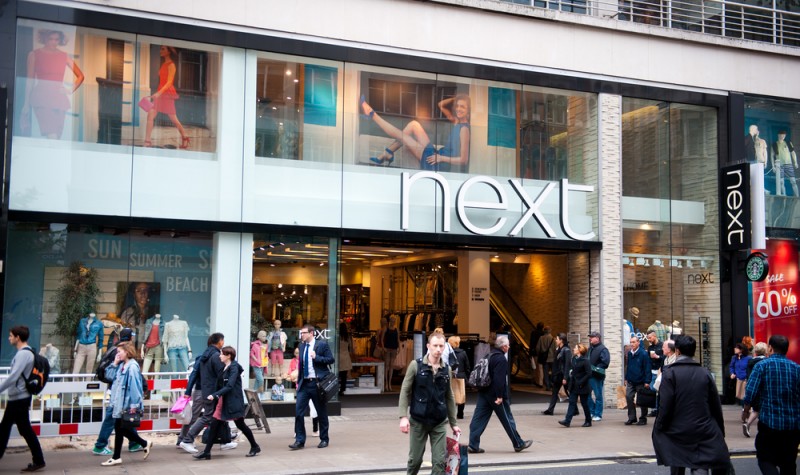A buying opportunity in NEXT?

Next (NXT) shares, at 6,860p after the Christmas trading period report, look good value on a one-year view. Should it prove a falling market generally, the estimated dividend yield gives the shares defensive qualities as well a useful income stream for their owners. Already, thoughts are stretching to next Christmas and that, in theory, should make the year-on-year sales comparatives easier, thanks to their outturn this year.
Referring back to my observations and notes on this company and its shares on the 19th of November 2015 – when the share price was 7,835p – I see that I had underlined a number of its performance characteristics: underscoring the then low earnings growth expectations of analysts’ consensus estimates; and remarking on its still remarkable cash generative qualities and its comparatively high dividend yield forecasts.
On past record and on the whole, that seemed a bit of a disappointing prospect for a formerly high-end earnings growth stock. However, the then estimated dividend yield prospects of 5.2% for the then current year and 5.4% for the next year, gave the shares an income stock valuation and implied a limit to how far the shares could fall; not that the chart, at that point, was suggesting a fall was on the cards.
Last November, the shares had pulled back to what looked like a long-term trend support level. As it turned out, it did not provide the support indicated on the chart. The share price collapsed through it, registering a historic change to the share’s price dynamics. The share price last seen was 6,860p, or 12.5% lower than last November’s price of 7,835p. This winter’s extraordinary December mildness played havoc with retailers’ forecast seasonal fashion demand. It seems that even the adaptable NEXT could not overcome that challenge, although the company did not put the resulting disappointing results all down to that.
The company reported that for the 60 days to Christmas Eve 2015, it did not reduce prices until the end. Fully priced items rose in price but only by the whisker of + 0.4% year on year; sale-priced items, meanwhile, fell 7.0% year on year. Although Next Directory sales increased 2.0% in those 60 days, shop retail sales were reported down –0.4%. Next own brand sales were reported up 0.4%. However, once you knock off the stated sales increase of 1.5% due to new space, the implied ‘like for like’ was down.
Clearly, one cannot expect much else when the winter weather fails to co-operate, as it did in 2015. Climate change is proving a real problem for suppliers of seasonal fashion. However, the company did declare reasons that were not merely due to unexpected seasonal weather. One was poor availability of some lines, and another was the fact that other companies previously behind in online selling were catching up with Next Directory.
For the year as a whole, to 2nd January 2016, shop retail sales were up 2.1%, Directory sales rose 6.1% and Next own brand items as a whole increased 3.7%. For the year, sales attributable to new space increased 1.6%.
In financial terms, the company gave guidance that we should expect a 4.4% increase in annual profits before tax to near £817 million, with earnings per share rising 4.8%. The ordinary dividend is indicated to increase 2.2% and the special dividend payment to increase by 3.3%. Adding dividends to earnings, that represents an internally generated return to equity of a declared 10.3%.
Addressing the outlook for 2016, the company gave a wide range of possibilities for NEXT’s own-branded items growth, ranging from between 1% to 6% with profits growing in line with sales.
It is to be recognised that although the share’s price to earnings ratio is that of a growth company, the actual increase in annual earnings per share does not justify the multiple on a conventional PEG (price to earnings growth) yardstick. That is to say, the multiple at which the shares currently change hands is much higher than the figure of the multiple. Under that convention of valuation, a percentage increase in earnings which is the same as the multiple is regarded as fair value – for example, a multiple of ten times for earnings growing at 10%.
According to the market consensus estimates of future earnings growth, Next’s Earnings this year and next, are forecast to grow at 8%. Yet the shares trade on estimated earnings multiples of eighteen times for this year and 17 times for next year. However, because the company is traditionally and currently cash generative, its prospective, estimated dividend yield is 5% for the year just beginning and 5.3% for the following year. That is a usefully above-average and reliable-looking dividend yield in a market particularly preoccupied with finding such income to pay pensions and to meet other financial obligations.
Thus, NEXT shares should be regarded as selling at a premium to earnings growth because of its dividend. In other words, the estimated prospective dividend yields of 5% and 5.3% justify the earnings multiple.
As long as NEXT remains cash generative, it will look attractive on dividend prospects. That seems highly probable in the near term, making the dividend estimates look sustainable and the shares look good value and useful as an income dispenser (when it is not using the cash to buy back shares).
Over a year, NEXT shares have risen 4.5%, thus significantly outperforming the FTSE100 Index as well as providing an above-average and growing dividend. As long as that continues to prove to be the case, the shares look like an attractive investment as part of a diversified portfolio of investments.
The Lord only knows what the weather will be like next year in the Christmas period. However, the year-on-year comparisons should be easier to beat, in theory. I think the shares look attractive on a year’s view against the current dividend yield estimates.
Comments (0)